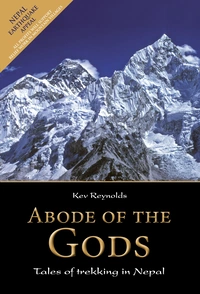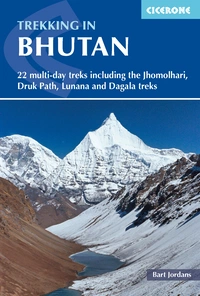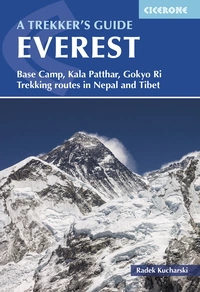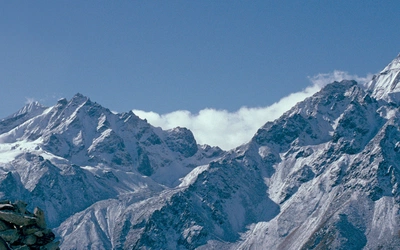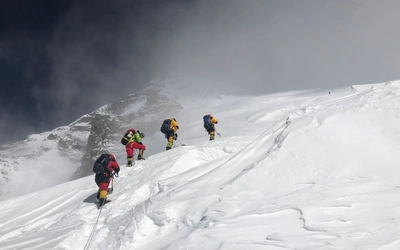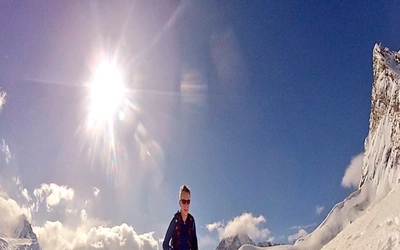Running on the roof of the world: The Everest Marathon
Running on the roof of the world is never going to give you a marathon personal best, but it will be an incredible, life-changing experience. If you love being in the mountains, want to get a close-up look at Everest, are fascinated by the Sherpa people or just love running, the Everest Marathon combines all these elements, and more.
Rounding the bend, the path levelled and we emerged from the trees to the amphitheatre of brightly coloured buildings set into the hillside. Namche Bazaar was so familiar, and yet things had changed. The muddy field where the Tibetan traders pitched their blue tents was now built on, and the stream where the women washed clothes was now a concrete-lined water feature. As a result of the 2015 earthquake, a new Gompa had been built – the fresh white paint bright in the sunlight. A train of yaks passed through the narrow, cobbled street, clanging in different notes from the bells around their necks. The aromas of dung, freshly ground coffee, and spices greeted us as we climbed the uneven paving. It was wonderful to be back.
This time, the purpose of my visit was to experience the Everest Marathon and decide if I wanted to take up the offer of being the new race director. The phone call from Diana Penny Sherpani, who created the Everest Marathon 34 years ago, left me in a state of shock – it was a prospect that was equally exciting and daunting. I had, in a small way, been at the start of the Everest Marathon, when the two of us created business plans together for our respective start-ups. Over the decades, many of my fell-running friends had gone to Nepal to run the highest marathon in the world or work on it as a team leader or doctor. This iconic event and I had history.
The first Everest Marathon took place in 1987, despite the dire predictions from medical and sports experts about running at high altitude. It seems it’s good not to heed the pessimists as the event was a huge success – entrants came from all over the world and the Everest Marathon made athletic history. In the early days, the trek started with a tortuous bus ride from Kathmandu to Jiri, the village at the end of the road. From there on in, it was full-on Himalayan trekking with lots of porters carrying tents to sleep and dine in, cooking pots, fuel and food for themselves and the runners. This was the same trek that Chris Bonington, Doug Scott and Dougal Haston had taken on the way for the first British ascent of the South West face of Everest in 1975.
As a running and climbing-mad teenager, I devoured stories of adventures in big mountains and had attended one of Doug Scott’s lectures. I’d seen images of glacial melt rivers being waded for lack of bridges and knew that it was polite to drink the salty yak milk tea offered when you were a guest in a villager’s home. Getting wet didn’t bother me but the thought of having to politely drink the tea and suffer with the inevitable trekkers’ diarrhoea meant I was in my 50s before I got myself to Nepal.
A lot has changed since those early days. The lodges now offer a range of alcoholic drinks, menus with Sherpa and a kind of European food, often amusingly mis-spelled. The cook teams in the lodges and on tented treks are trained in food hygiene and know that the lucrative tourist industry requires good, tasty food that stays in the gut. Swiss-made metal bridges now span the Dudh Khosi – the turquoise-white river rushing down from glaciers. Porters are still carrying heavy loads up the valley, but now there is a weight limit of 30kg, better footwear and health provision, thanks to organisations like Porters’ Progress and Community Action Nepal (CAN), the charity set up by Doug Scott to support health and education projects in rural Nepal. Both charities have been instrumental in building porter rescue shelters and medical posts in the high valleys.
Over the past 34 years the Everest Marathon has raised £770,000 as a result of runners from around the world fundraising to support rural development projects in Nepal. Having decided to retire, Diana passed the ownership of the Everest Marathon to CAN and I took on the role of race director – a delightful and daunting task in equal measures. As Helen Keller said: ‘Life is either a daring adventure or nothing at all.’
What is it about this event that makes people really want to take part?
It could be described as a trip of a lifetime to journey from the rush and colour of Kathmandu to the cold, quiet of the high mountains surrounding Everest – except that some people come back for a second time!
Many people have a lifelong ambition to go to Everest Base Camp, to see for themselves the scale of the landscape and know what it feels like to tread in the footsteps of the great early adventurers. For others, it’s the lure of the unknown and the challenge of finding how they will cope with the cold and the altitude. There are those who choose to run a marathon on every continent – certainly, the highest marathon in the world competes well with the coldest and hottest as a great test of fitness and willpower. Then there are people who are drawn to the event as a means of making a difference in the world by fundraising for CAN.
But whatever the reason, they find in the end that it’s the journey itself that matters more than the one-day marathon. It provides an opportunity to find space in a busy world, connect with like-minded people and expand awareness.
What does the Everest Marathon consist of?
It’s a challenge just getting to the start of the marathon at 5200m, feeling fit and ready to run. The marathon is a measured 26.2 miles, and the start line is at the original Everest Base Camp at Gorak Shep, the highest habitation point on the planet. The good news is that from here it’s downhill – that is, the finish is at a lower altitude of 3440m, but there’s a small sting in the tail with a super-steep descent into a valley followed by a climb of 990m up the other side.
If you’ve seen the BBC documentary Life at the Extreme showing Mira Rai winning the Everest Marathon, then you’ll have seen the start line bathed in sunshine. This was just for the cameras. The reality is that the start is brutal – at 6am, the sun hasn’t yet risen over the mountains, and the glacial landscape feels as cold as it looks. Duvets are shed at the very last moment before the cry of ‘Go’ is shouted.
Given that so many popular races are brutal affairs, it seems people really do want to test their mettle by signing up to pain-inducing, sleep-depriving, battle-against-the-elements experiences. The marathon should rank high on the list of must dos! Trekking days are measured in hours of ascent rather than distance. So, we make our way slowly uphill, carrying just a day sack. The yaks, porters and cooks do all the work, getting the food, fuel and tents up the valley. It’s a very relaxing way to exist and the ‘pushing on’ mentality of runners is turned upside down – maybe the person who rests when they reach camp rather than the person who goes for a training run will be the one who has more left in them for the marathon.
And the wonderful thing is that most of the 23-day experience is really easy, what great holidays are made of – a good dose of luxury, new experiences and fabulous views. And the colbalt-blue sky certainly beats a November in Britain. The luxury comes at the beginning and end, each with two nights at the Hotel Shanker in Kathmandu. From 1894 to 1964, this was the residence of the royal family of Nepal; after that, it was converted into a luxury hotel. Stepping into the gardens and leaving the vibrant, noisy city outside the walls, we enter an oasis of calm and old-world charm.
The trek leading to the marathon
We get the early flight from Kathmandu to Lukla – the airport with the infamous landing strip, now boasting a tarmac runway. The noise and pollution of the city are left behind, and we enter a world of clean, sharp air, lush green vegetation and bright-white snow-covered peaks. Our path follows the river upstream, crossing suspension bridges adorned with sun-bleached prayer flags. Turning the prayer wheels as we pass by, we can ask for blessings from the Gods for our safe journey.
The acclimatisation process has started and there are 15 days of trekking before the morning of the marathon – the point of focus for everyone in the group. We take our time on the ascent, acclimatising naturally. Our trek to the start is the marathon route in reverse, so everyone gets to learn it. But our journey takes in two areas off the main Everest Base Camp route, so we can enjoy quiet mountain time, get to see even more beautiful and varied landscapes, and give ourselves more time to acclimatise.
Namche Bazaar is the Sherpa capital. Nestled in a natural bowl, surrounded by jagged peaks, it is layered with brightly painted lodges and shops. For years, the town accumulated wealth as a result of traders walking over the pass from Tibet. Now its business comes from trekkers and climbers on their way to Everest, with the inevitable consequences of fast growth – a lack of infrastructure to support the extra accommodation and the old charm losing to modernisation. There is plenty to do here – visit the Sir Edmund Hillary School and hospital in Khunde, set up by the Himalayan Trust; have a drink at the Everest View Hotel, drinking in your first really great view of the mountain; or tour the shops and cafés in the town. It’s a great place to buy any last-minute must-have gear as the prices are low – you didn’t really think it would be an authentic Marmot down jacket at that price, did you!
Machermo, a settlement at 4410m, lies in a wide, sheltered valley bottom that is perfect for our tents. This is our base for three nights, allowing the body time to adjust to the gain in altitude. There’s hardly anyone else in this lovely valley, as they’re all in such a hurry to get to Everest Base Camp and back down again. Climbing up the valley to Gokyo is a delight. The valley becomes a little steeper, and then we meet the first of the three sacred lakes – sparkling turquoise glacial melt water hosts a family of Brahmini ducks. The tea houses at Gokyo have views over the third lake and the ‘hill’ of Gokyo Ri. At 5357m, it feels more of a mountain, but getting up there is worth the effort as the views of Everest’s south face and the dry Ngozumba Glacier are spectacular.
After gaining all that height, we descend into full-fat air and rejoin the marathon route. After a stiff climb up through the forest, we come out into the open at Tengboche, home of the most important Buddhist monastery in Nepal. Learning about the Sherpa way of life and religion is part of the experience of journeying through this valley, and we can join the monks in the Gompa for the afternoon ceremony. Another attraction is the café. It’s surreal to be drinking proper coffee and eating excellent cake with the summits of Ama Dablam, Thamserku and Tawache dominating the skyline, while the local ponies extend their necks over the wall and nuzzle for crumbs.
When the race route in the main valley turns north, we take the path to the east, to Dingboche for two nights of acclimatisation at 4410m. On our day off, we can explore the quiet Imja valley, walking to Chhukung on the route to Island Peak (6180m). Gaining altitude takes its toll on the body, and it’s important to look after ourselves in every way we can. Sea Buckthorn bushes grow at this altitude. When the berries are pressed, the pink juice produces the most delicious drink. But that’s not all – this plant is full of anti-oxidants, vitamins C, A, B1, B2, B6 and E, amino acids and minerals. It is wonderful for treating a host of ailments. It’s worth taking a walk to Dingboche just to get a good immunity-boosting dose.
Back on the marathon route at Lobuche, we’re joined by the Nepali runners. They are already well acclimatised and don’t need a slow ascent, but they do need a pre-marathon medical and kit check, along with all the international runners. Here is the crunch point – will individuals be declared fit and able to join the start line tomorrow?
Most people will already have walked up Kalar Pattar (5500m) or made their way to the piece of glacier that is Everest Base Camp (5465m) the previous day and come back down to Lobuche to sleep. Now we move up to Gorak Shep with the large area of sandy ground that provides the start of the OEM. In 2011, when there were just a few lodges and the runners camped the night before the marathon, they woke up to several inches of snow. The change in climate is no doubt responsible for the subsequent lack of snow at this time of year but whether it’s snowing or not, up here, at 5200m, it’s very, very cold.
Marathon day means an early start and runners nervously fumbling with the safety pins to attach their numbers. The people expected to run a faster race will set off an hour later than the 6amers. By 7.30am the sun will have climbed over the mountain and warmed the limbs of the runners. Clothes will be shed as the runners make their way down the valley and the faster runners will be finishing in shorts and vest. Doctors and team leaders are stationed along the route, along with the people who have come to support their running partners by marshalling at the control points.
At the finish in Namche Bazaar, the rest of the support team will be watching the computer screen as the trackers display the movement of runners down the valley and beam the runners’ positions across the world. For many years the Nepali runners have dominated the men’s race. Ram Kumar Raj Bhandari holds the record in 3hr 40mins, but the Nepali women haven’t been able to match Anna Frost’s time of 4hr 35mins. The question for this year is whether Marcus Scotney, famed for his record-breaking run in the 2017 Dragons Back, will be able to snatch the winner’s title.

